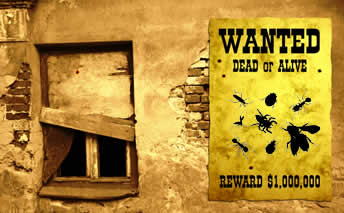Techletter.com's Top 10 Most Unwanted Pests
Listed in alphabetical order:
-
Argentine ant
- The Argentine ant is notorious for its persistence in invading houses. Another alien invader of the United States, this ant came from Argentina and Brazil, and was first introduced into the U.S. in the late 1800's. It is now a major pest across the southern U.S. and in California, with isolated infestations in other areas. Failure is common when trying to control Argentine ants. Callback rates can exceed 50 percent. Success requires careful inspection and a combination of control tactics. More on Argentine ant ID, biology, and habits...
-
Bed bug
- Bed bugs are on the march, infesting more and more locations nationwide. They're not just a problem at hotels: they're also a growing concern with cruise ships, universities, hospitals, nursing homes, assisted living facilities, military barracks, condominiums, apartments and residences. The pests' myriad modes of transportation pose a problem to businesses, homeowners and pest control professionals. They are difficult and expensive to control. Bed bugs can be active migrants, walking to new areas on their own six legs. They also can be hitchhikers (traveling by way of packages, luggage, planes, trains, automobiles — you name it). More on bed bug ID, biology, and habits...
-
Drosophila (fruit) fly
- This group of flies has many names: fruit fly, vinegar fly, pomace fly, Drosophila fly (for the genus), and X$%&* sonofa &@*@ (censored). The latter name is commonly given by those trying to control these frustrating pests, particularly in commercial food operations. Remarkable numbers can breed in small amounts of rotting fruit, vegetables, fermenting liquids, even contaminated mop water that has seeped into floor cracks. One dirty mop can breed thousands of fruit flies, and plagues of these flies can infest restaurants and other food facilities. More on fruit fly ID, biology, and habits...
-
German cockroach
- The German cockroach was once unchallenged as public enemy number one in buildings. Pest control technicians working in apartments in the 1970's would commonly see infestation so bad that the cockroaches were literally falling from the ceilings. An insecticide sprayed into a crack behind a kitchen sink might flush a hundred or more cockroaches out into the open--much to the distress of the resident. With the development of cockroach baits, however, the German cockroach became far less of a pest, although never completely disappearing. Now they are making a comeback , and are once again in the top ten. More on German cockroach ID, biology, and habits...
-
House fly
- The house fly was so named because it was once the most important pest in and around houses. While still a household pest, the house fly is considered more of a public health pest because of its potential to transmit disease organisms from fecal material to human food in restaurants, hospitals, and other sensitive sites. Interestingly, while most everyone has heard of the house fly, few people can tell them from other flies. More on house fly ID, biology, and habits...
-
House mouse
- For such a cute little mammal, the house mouse generates a remarkable degree of fear and loathing in many people. Perhaps this is because this mouse can live in high numbers in our own homes, the only evidence being the hundreds of mouse droppings that appear on our counter tops, and the occasional glimpse of a mouse scurrying rapidly past our feet. Mice can be very difficult to control in apartments, office buildings, and food storage or processing plants because of their secretive nature and amazing breeding potential. They are probably the second most successful mammal on earth (after us, of course). More on house mouse ID, biology, and habits....
-
Indianmeal moth
- In the food industry, and really anywhere food is stored, the Indianmeal moth has to be considered the number one pest of stored foods, and especially in the seed, pet food, popcorn, and grain industries. They can build up to high numbers in stored products. Fumigation is usually necessary to control these pests once established in commercial food operations. More on Indianmeal moth ID, biology, and habits...
-
Odorous house ant
- Named for its rotten-coconut odor, this ant is a native of the United States and can be found almost everywhere. It is increasing in importance and can be difficult to control because colonies tend to be large with many queens. There can be multiple nest sites and even multiple colonies in and around a building. More on odorous house ant ID, biology, and habits...
-
Subterranean termite
- Termites cause billions of dollars in damage to homes and other buildings every year, and subterranean termites are the major culprits. Native to every state except Alaska, underground termite colonies may contain thousands and up to several million individual termites, living as deep as 20 feet underground. Feeding on wood and other cellulose, termites find that our homes and businesses offer the ideal combination of warmth, moisture and food. More on subterranean termite ID, biology, and habits...
-
Yellowjacket
- No one likes being stung by a wasp, and no wasps are more aggressive in defense of their colonies than yellowjackets. Stings are painful, and each yellowjacket can sting multiple times, and recruit dozens of sisters to join the attack. Some yellowjackets nest in the ground, some in aerial nests, and some inside buildings. More on yellowjacket ID, biology, and habits...


